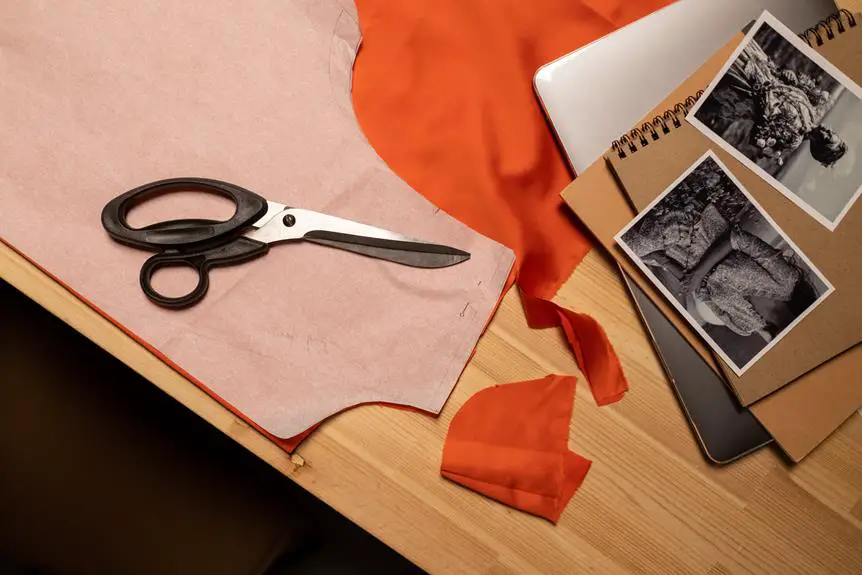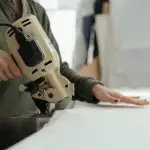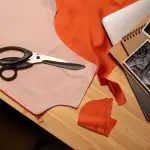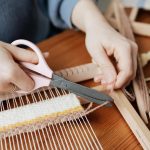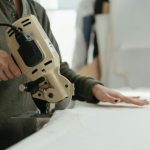Looking for the perfect pair of sewing scissors for fabrics? Finding the finest tool for trimming textiles is crucial for achieving clean, crisp cuts. Selecting the best sewing scissors involves considering factors such as blade material, handle design, and cutting precision.
To master your sewing projects, it's essential to invest in high-quality scissors that suit your specific needs and preferences. Whether you're working with delicate silks or sturdy denims, the right pair of scissors can make a world of difference in your crafting experience.
So, let's explore the key features and top brands to help you make an informed decision and elevate your sewing skills.
Key Takeaways
- Durability and precision of the blades are important factors to consider when selecting sewing scissors for fabrics.
- Different types of blades, such as serrated or micro-serrated, are ideal for specific fabric types and cutting needs.
- Ergonomic handle design and comfortable grip are essential for reducing hand fatigue during extended use.
- Top sewing scissors brands like Fiskars, Gingher, Kai, Mundial, and Tula Pink offer high-quality options with various features for different cutting requirements.
Types of Sewing Scissors
When choosing sewing scissors, consider the durability and precision of the blades. Blade types play a crucial role in determining the suitability of the scissors for specific fabric types and cutting techniques. For instance, serrated blades are ideal for gripping and cutting slippery or delicate fabrics, while micro-serrated blades provide excellent precision when working with fine details.
Additionally, the handle materials can significantly impact your cutting experience. Scissors with ergonomic handles made from materials like rubber or silicone provide a comfortable grip and reduce hand fatigue during extended use.
Understanding different cutting techniques is also essential for selecting the right sewing scissors. For instance, pinking shears are perfect for preventing fraying along the edges of fabric, while duckbill scissors are designed to trim close to the fabric without the risk of snipping through it.
Moreover, knowing the appropriate sharpening methods for your scissors is crucial for maintaining their effectiveness. Regular sharpening using a sharpening stone or professional sharpening services can extend the lifespan of your sewing scissors and ensure clean, precise cuts.
Factors to Consider
When choosing the best sewing scissors for fabrics, consider the balance between sharpness and weight, as well as the ergonomic handle design.
The sharpness of the scissors ensures clean and precise cuts, while a comfortable and ergonomic handle design can reduce hand fatigue during long sewing sessions.
Sharpness Vs. Weight
You should prioritize sharpness over weight when choosing sewing scissors for fabrics. Sharpness is crucial for achieving clean, precise cuts, especially when working with delicate or intricate fabrics. While weight is important for comfort during extended use, it shouldn't overshadow the significance of sharpness.
Here are some factors to consider when evaluating the balance between sharpness and weight:
- Sharpness: Opt for scissors with razor-sharp blades to effortlessly cut through various fabric weights.
- Durability: Look for scissors made from high-quality materials to ensure long-lasting sharpness and performance.
- Weight: Consider a balance between a lightweight design for maneuverability and a sufficiently weighted handle for stability.
- Maneuverability: Prioritize scissors that allow nimble movements and intricate cutting without causing hand fatigue.
Ergonomic Handle Design
To achieve optimal comfort and precision when using sewing scissors for fabrics, focus on selecting scissors with an ergonomic handle design that complements the sharpness of the blades.
Look for scissors with a comfortable grip to reduce hand fatigue during extended use. Customizable handles that offer finger support can also enhance your cutting experience, allowing you to maintain control and accuracy while minimizing strain on your hand and wrist.
When considering ergonomic handle designs, prioritize options that suit your hand size and grip preferences. By prioritizing a comfortable and supportive handle, you can elevate your sewing experience and achieve cleaner, more precise cuts with less effort.
Ultimately, the right ergonomic handle design can make a significant difference in your sewing projects, improving both comfort and cutting performance.
Top 5 Sewing Scissors Brands
When it comes to selecting the best sewing scissors, the brand you choose can make a big difference. Quality steel blade options and ergonomic handle designs are key considerations when looking at the top 5 sewing scissors brands.
Each brand brings its own unique features and benefits to the table, so it's important to weigh your options carefully.
Quality Steel Blade Options
For precise and effortless fabric cutting, consider the reliability and durability of steel blades in the top 5 sewing scissors brands. When it comes to quality steel blade options, the following brands stand out:
- Fiskars: Known for their customized grips and rust resistance, Fiskars offers versatile cutting and precision handling.
- Gingher: Renowned for their precision-ground blades, Gingher scissors provide exceptional sharpness and durability.
- Kai: With a reputation for high-quality Japanese steel, Kai scissors are favored for their smooth, precise cutting abilities.
- Mundial: Mundial scissors feature fine, stainless steel blades that ensure long-lasting sharpness and rust resistance.
These top brands are dedicated to providing superior steel blade options, ensuring that your fabric cutting experience is unparalleled in terms of precision and longevity.
Ergonomic Handle Designs
Consider choosing sewing scissors with ergonomic handle designs from the top 5 brands to ensure comfort and precision in your crafting projects. A comfortable grip is essential to prevent hand fatigue and potential issues like carpal tunnel and wrist strain.
When selecting the best sewing scissors for fabrics, look for brands that prioritize ergonomic handle designs. Fiskars is known for its Softgrip handle that reduces discomfort during extended use. Additionally, Gingher's contoured handles provide excellent control and a natural fit for your hand.
Kai sewing scissors offer an ergonomic handle that minimizes hand strain, making them ideal for long sewing sessions. Mundial's ergonomic cushioned grip reduces pressure on your fingers, while Tula Pink's micro-serrated scissors feature comfortable handles designed for precision cutting without hand fatigue.
Ergonomic Design Features
To ensure comfort and reduce hand fatigue during long sewing sessions, you should look for sewing scissors with an ergonomic handle design. Ergonomic design features play a crucial role in ensuring that your sewing scissors are comfortable to use, especially for extended periods. Here are some essential ergonomic design features to consider when choosing sewing scissors:
- Comfortable Grip: Look for scissors with handles that provide a comfortable grip, allowing you to hold them without strain or discomfort.
- Hand Fatigue Reduction: Seek out scissors specifically designed to reduce hand fatigue, ensuring that you can work on your sewing projects for longer periods without experiencing discomfort.
- Finger Support: Opt for scissors with finger support features that help distribute pressure evenly across your fingers, reducing strain and potential discomfort.
- Cushioned Handles: Consider scissors with handles that are cushioned or padded, providing additional comfort and support during use.
Specialty Scissors for Different Fabrics
When selecting specialty scissors for different fabrics, prioritize the unique blade designs tailored to specific materials, ensuring precise and clean cuts.
For delicate fabrics like silk, chiffon, or satin, consider using fine, sharp scissors with a slender tip to prevent fraying and ensure accuracy.
For heavier fabrics such as denim or upholstery materials, opt for strong, durable scissors with serrated or bent blades to tackle the thickness and prevent slippage.
When working with knits, choose scissors with a micro-serrated edge to grip the fabric and cut smoothly without stretching or distorting the material.
Care is essential to maintain the sharpness of specialty scissors. Always store them in a protective case, avoid cutting paper or other non-fabric materials, and regularly sharpen or replace them when needed.
Additionally, mastering cutting techniques for different fabric types is crucial. For instance, using tailor's chalk to mark patterns on dark fabrics or pinning slippery materials before cutting can significantly improve precision and reduce errors.
These cutting techniques and care tips are essential for ensuring your specialty scissors remain effective and your fabric cutting endeavors successful.
Maintenance Tips for Sewing Scissors
To maintain your sewing scissors in top condition, regularly wipe the blades with a clean, dry cloth to remove any lint or residue. Proper maintenance is essential for ensuring the longevity and performance of your sewing scissors. Here are some maintenance tips to keep your scissors in excellent shape:
- Proper Storage: Store your sewing scissors in a dry environment to prevent rust and corrosion. Consider using a scissor case or sheath to protect the blades from damage and to keep them sharp.
- Sharpening Techniques: Learn how to sharpen your sewing scissors properly. Invest in a high-quality scissor sharpener or seek professional sharpening services to maintain the sharpness of the blades.
- Rust Prevention: Apply a thin coat of oil to the blades regularly to prevent rust and corrosion. Be sure to wipe off any excess oil before using the scissors on fabric to avoid staining.
Budget-Friendly Options
Consider purchasing a set of budget-friendly sewing scissors that provide quality performance without breaking the bank. Look for options that offer sharp, stainless steel blades to ensure precise cutting without fraying the fabric. While these budget-friendly options may not have all the bells and whistles of higher-end scissors, they can still meet your basic cutting needs effectively.
When using budget-friendly sewing scissors, it's important to employ proper cutting techniques to maximize their performance. Always use the full length of the blades to achieve clean, straight cuts, and avoid cutting materials that are too thick for the scissors to handle, as this can damage the blades.
In addition to using proper cutting techniques, it's crucial to follow care instructions to prolong the life of your budget-friendly sewing scissors. Clean the blades regularly to remove any built-up residue, and store the scissors in a dry environment to prevent rust or corrosion. Proper handling and storage recommendations will help ensure that your budget-friendly sewing scissors continue to perform well over time.
Where to Buy Quality Sewing Scissors
Where can you find high-quality sewing scissors that offer durability and precision for your fabric projects? Look no further, as there are several options available to you:
- Online Retailers: Many reputable online retailers offer a wide selection of high-quality sewing scissors. You can browse through various brands, read customer reviews, and compare prices all from the comfort of your home.
- Local Shops: Visit your local specialty sewing or crafting stores. These shops often carry a curated selection of sewing scissors, and you may have the opportunity to test them out before making a purchase.
- Vintage Scissor Collectors: Seek out vintage sewing scissors from collectors or antique stores. Vintage scissors are often known for their exceptional craftsmanship and can add a unique touch to your sewing toolkit.
- Custom Made: Consider having sewing scissors custom made for you. Some artisans and blacksmiths specialize in crafting custom scissors, allowing you to personalize the design and specifications to meet your exact needs.
Frequently Asked Questions
Can Left-Handed Individuals Use the Sewing Scissors Recommended for Right-Handed Users?
Yes, left-handed individuals can adapt to sewing scissors recommended for right-handed users. The scissor grip may need adjustment for comfortable use. Look for scissors with an ambidextrous grip or specialized left-handed models for optimal cutting experience.
Are There Any Sewing Scissors Specifically Designed for Individuals With Arthritis or Hand Pain?
Looking for sewing scissors designed for arthritis relief? Consider ones with an ergonomic design to reduce hand fatigue. These can provide comfort and ease for those with hand pain, making your sewing experience more enjoyable.
Do Any of the Recommended Sewing Scissors Come With a Warranty or Guarantee?
Yes, some of the recommended sewing scissors do come with a warranty or guarantee. This ensures quality assurance and product durability. If you have any issues, the customer service will assist you with warranty coverage.
Are There Any Sewing Scissors That Are Specifically Designed for Cutting Delicate or Sheer Fabrics?
When cutting delicate or sheer fabrics, it's crucial to use scissors specifically designed for fabric care and material compatibility. Proper scissor maintenance and cutting techniques are essential for preserving the integrity of these delicate materials.
Can the Recommended Sewing Scissors Be Used for Other Crafting Activities, Such as Paper Cutting or Embroidery?
Yes, the recommended sewing scissors can be used for other crafting activities. They are versatile and suitable for paper cutting and embroidery techniques. The sharp blades and comfortable handles make them ideal for various crafting needs.

